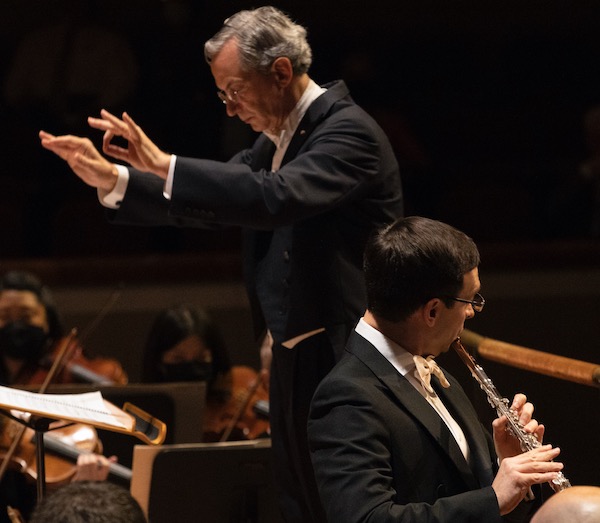Luisi leads Dallas Symphony in American concerto and colorful trip to Italy

The Dallas Symphony Orchestra provided a colorful concert of program music Thursday night at the Meyerson Symphony Center. Led by music director Fabio Luisi, the orchestra showcased music of Weber, Joan Tower, and Richard Strauss (seemingly a favorite of Luisi), with a splendor that shone consistently.
The opening horn call of Carl Maria von Weber’s Overture to Oberon, a quotation from the opera that summons the title Elf-King, provided a warm and sensuous start to the program. Followed by muted strings and iridescent winds, Weber’s curtain-raiser nicely sets a magical, arborescent scene and Luisi’s gentle finesse was apt. here. Oddly, the fanfare, which Weber marks “as softly as possible,” was played far too loudly. Still, Luisi and the DSO managed to convey the imagery of Oberon’s narrative and central characters with great effect.
The opening horn call of Carl Maria von Weber’s Overture to Oberon, a quotation from the opera that summons the title Elf-King, provided a warm and sensuous start to the program. Followed by muted strings and iridescent winds, Weber’s curtain-raiser nicely sets a magical, arborescent scene and Luisi’s gentle finesse was apt. here. Oddly, the fanfare, which Weber marks “as softly as possible,” was played far too loudly. Still, Luisi and the DSO managed to convey the imagery of Oberon’s narrative and central characters with great effect.
The opening horn call of Carl Maria von Weber’s Overture to Oberon, a quotation from the opera that summons the title Elf-King, provided a warm and sensuous start to the program. Followed by muted strings and iridescent winds, Weber’s curtain-raiser nicely sets a magical, arborescent scene and Luisi’s gentle finesse was apt. here. Oddly, the fanfare, which Weber marks “as softly as possible,” was played far too loudly. Still, Luisi and the DSO managed to convey the imagery of Oberon’s narrative and central characters with great effect.
After announcing its “Women in Classical Music” initiative in 2018, the DSO has managed to include at least one work by a woman composer in its main concert series each season. Thursday night’s program featured Joan Tower’s Concerto for Flute and Orchestra.
The concerto calls for chamber orchestra accompaniment with reduced winds and brass, here yielding a lovely balance between soloist and ensemble. It is a one-movement work in 15 minutes, with flute alternating reflexively between lush introspection and athletic bravado.
DSO principal flutist David Buck was virtuosic in this blending of moods, evenly present on bright highs and brassy lows. With full, fluid lines, he was robust as both companion and foil to the orchestra as they navigated whirling shifts in collaboration and opposition between solo and ensemble.
Luisi’s command of sonic balance was demonstratively thoughtful here, with an even temperament in his gesturing. Buck’s agile, muscular phrasing provided energy and momentum as the group raced toward the work’s dark, stately close.

After a brief first half, the second half was dominated by Richard Strauss’ Aus Italien. Completed at the ripe age of 22, it is the first of his many tone poems (or “symphonic fantasies”), and was inspired by a trip to Italy in the spring of 1886. With an emphasis on programmatic descriptiveness, it conjures up idyllic images of charming countrysides and contemplative seascapes. In four movements, each a tone poem in its own right, the 47-minute work glints with evident influences of Liszt and Wagner—thick and rich in texture with supple lyricism.
Luisi and the DSO opened the piece with a welcome sort of glow, which opened into lusciously flowing phrasing. The energetic second movement was made light and lively by the musicians through effective tempo changes and attentive dynamic considerations. The movement was almost militaristic in its allusions to Roman ruins, but well-balanced between brass and others so as not to detract from the romanticism of Strauss’ luxurious colorations.
The third movement presented some challenges in tuning for the strings when answering the winds on the main theme of the middle section. The finale, however, righted the balance. Based on Luigi Denza’s tarantella “Funiculí, Funiculá,” the performance was given energy and coordination, culminating in a rousing coda.
The program will be repeated 3 p.m. Sunday. dallassymphony.org


